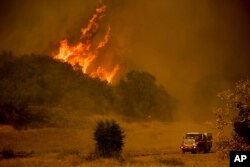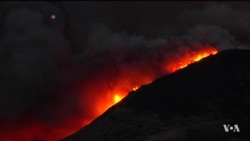California Governor Jerry Brown cautioned Saturday that more wildfires were in his state's future, as firefighters battled six major blazes that have killed at least one person and damaged hundreds of homes.
Brown surveyed fire damage in Ventura County, just north of Los Angeles, the scene of some of the worst destruction of the past week.
"This is the new normal," he said, blaming climate change for the increased danger of wildfires late in the year.
"We're facing a new reality in the state where fires threaten people's lives, their property, their neighborhoods, and of course billions and billions of dollars" in damage, Brown told reporters.
Late Friday, officials said they had linked the death of a 70-year-old woman in a car accident to the fires. Ventura County medical examiner Christopher Young said Virginia Pesola was fleeing the Thomas Fire in her car, following an evacuation route, when she crashed and died.
Young said the cause of death was blunt force injuries and smoke inhalation.
About 87,000 people remained evacuated from their homes, down from a height of more than 200,000 earlier this week.
Since Monday, the fires have burned more than 670 square kilometers (260 square miles). New fires keep erupting in dry conditions, though, and are being stoked by relentless westward Santa Ana winds, which are expected to gust up to 80 kilometers per hour (50 mph) on Sunday.
About 8,700 firefighters, accompanied by helicopters, continued to spray and dump water and fire retardant to try to slow the spread of the blazes that have erupted along the Pacific Coast from San Diego to Santa Barbara County, about 370 kilometers (230 miles) to the north.
President Donald Trump responded to the fires Friday by issuing a federal declaration of a state of emergency for California, paving the way for federal agencies to help coordinate relief efforts.
The biggest and most destructive blaze is the Thomas Fire, about 90 kilometers (56 miles) northwest of Los Angeles. It has charred nearly 580 square kilometers (224 square miles) and destroyed nearly 440 structures.
As firefighters made progress against the Los Angeles-area fires, most evacuation orders were lifted.
One of the newer blazes, the Lilac Fire, broke out Thursday in San Diego County, more than 200 kilometers (125 miles) south of Los Angeles.
The fire burned 16 square kilometers (6 square miles) in mere hours as it swept through the densely populated Rancho Monserate Country Club community and the small city of Fallbrook, home to numerous horse ranches and avocado orchards. Officials said 85 structures were quickly destroyed.
Officials said a smaller fire erupted Friday in San Diego County, about 50 kilometers (31 miles) east of downtown San Diego. They said the fire was small compared with the Lilac Fire and that numerous resources would be sent to fight it.
WATCH: Warming Arctic, Drier Regions and Wildfires: Is There a Link?
Fires are not uncommon in Southern California this time of year, before the winter rains set in, when the vegetation is tinder dry and winds blast the region. This year, however, has been particularly bad for California fires because of dry, hot and windy conditions that would be extreme for any season, including the winter season that is just two weeks away.
Just weeks ago, wildfires that broke out in Northern California killed 44 people and destroyed 8,900 homes and other buildings.













